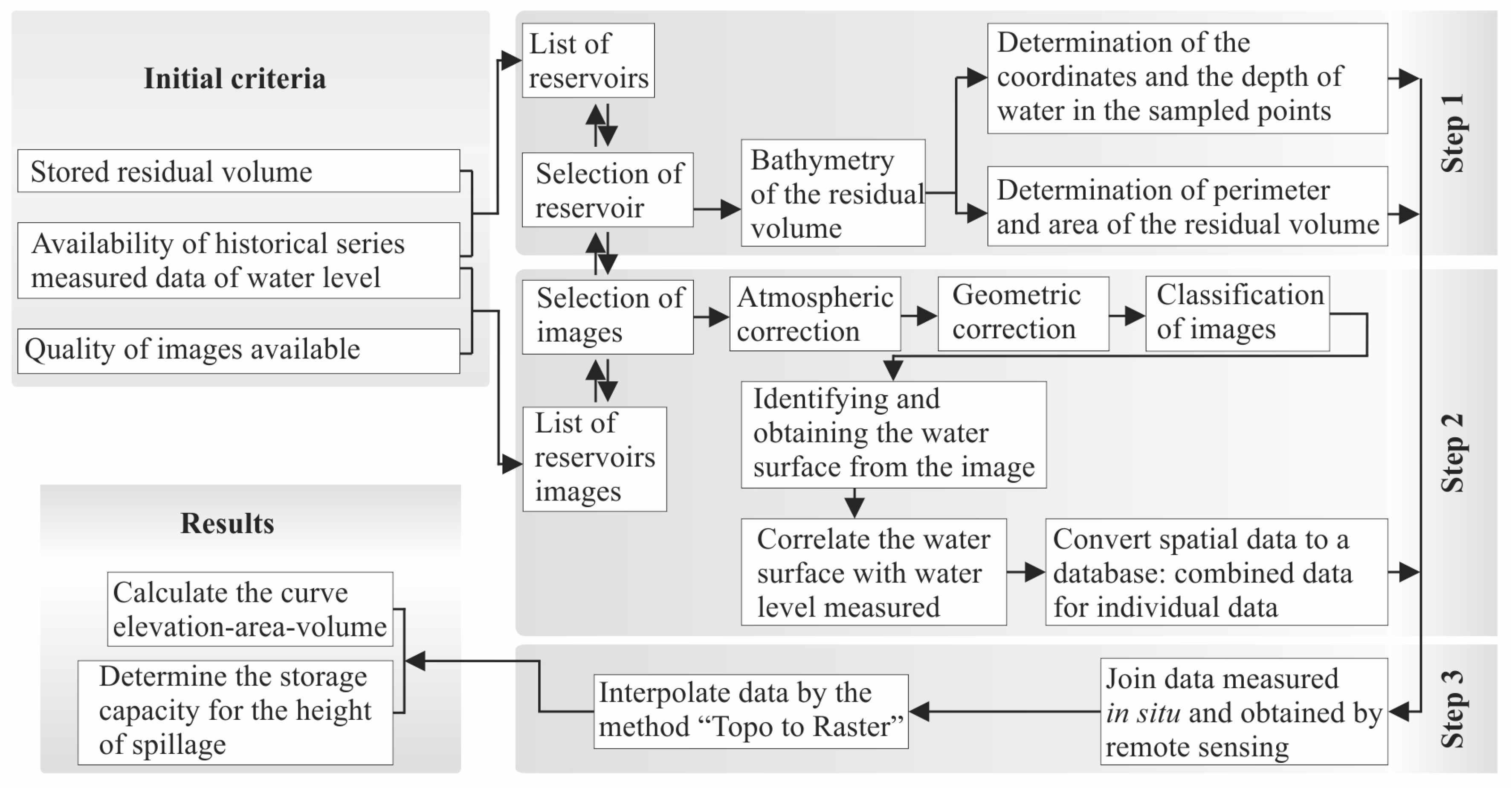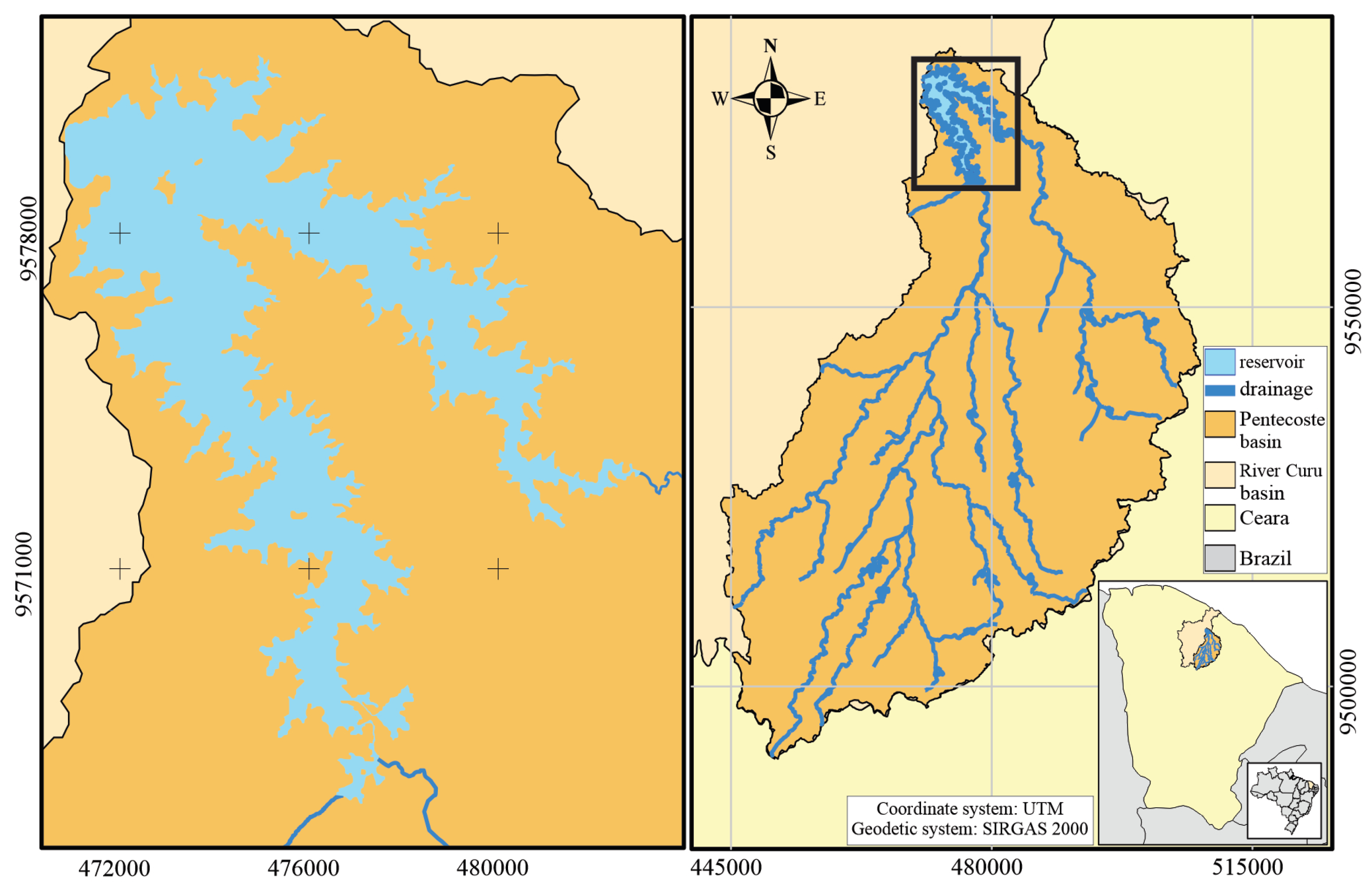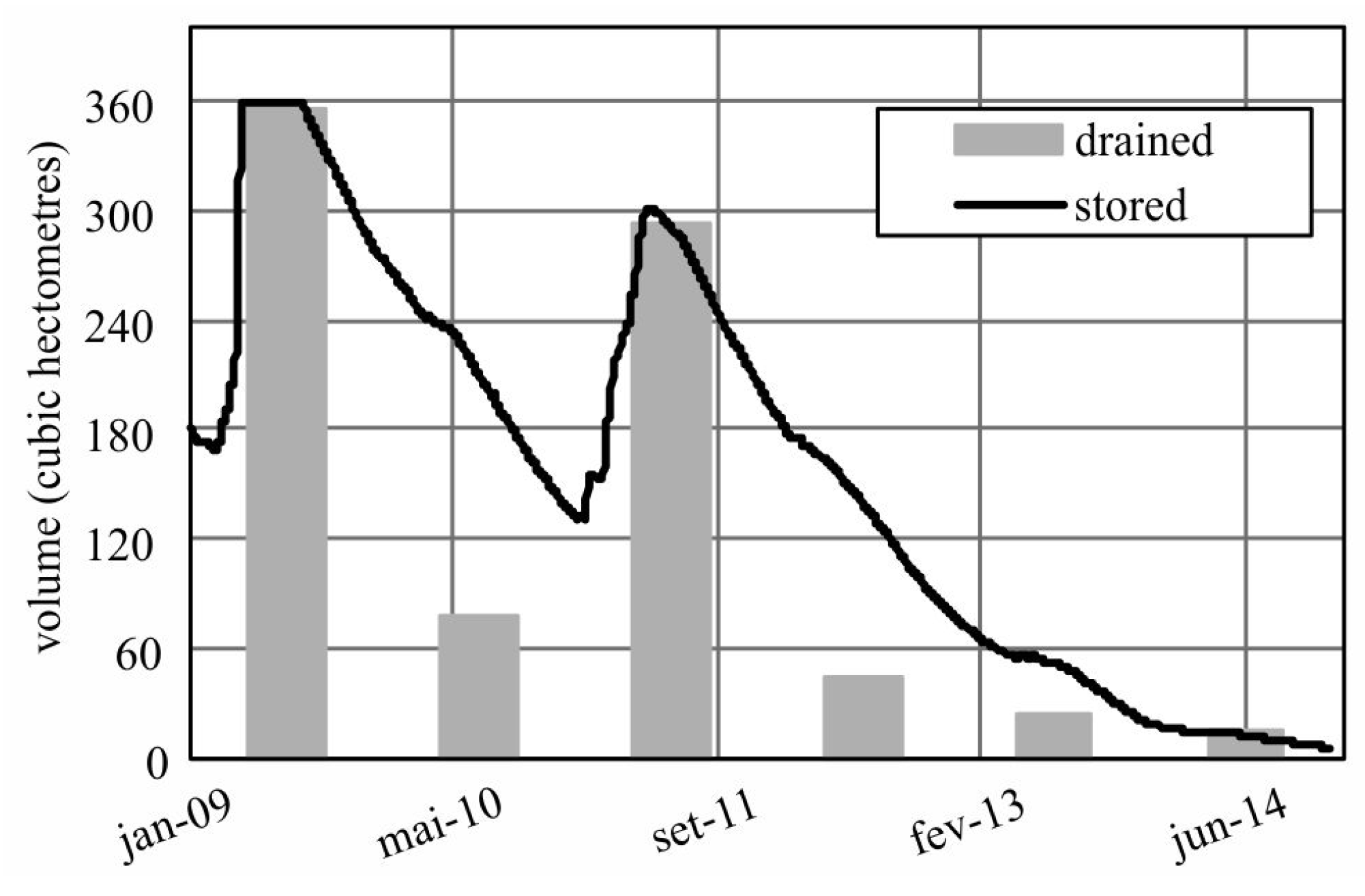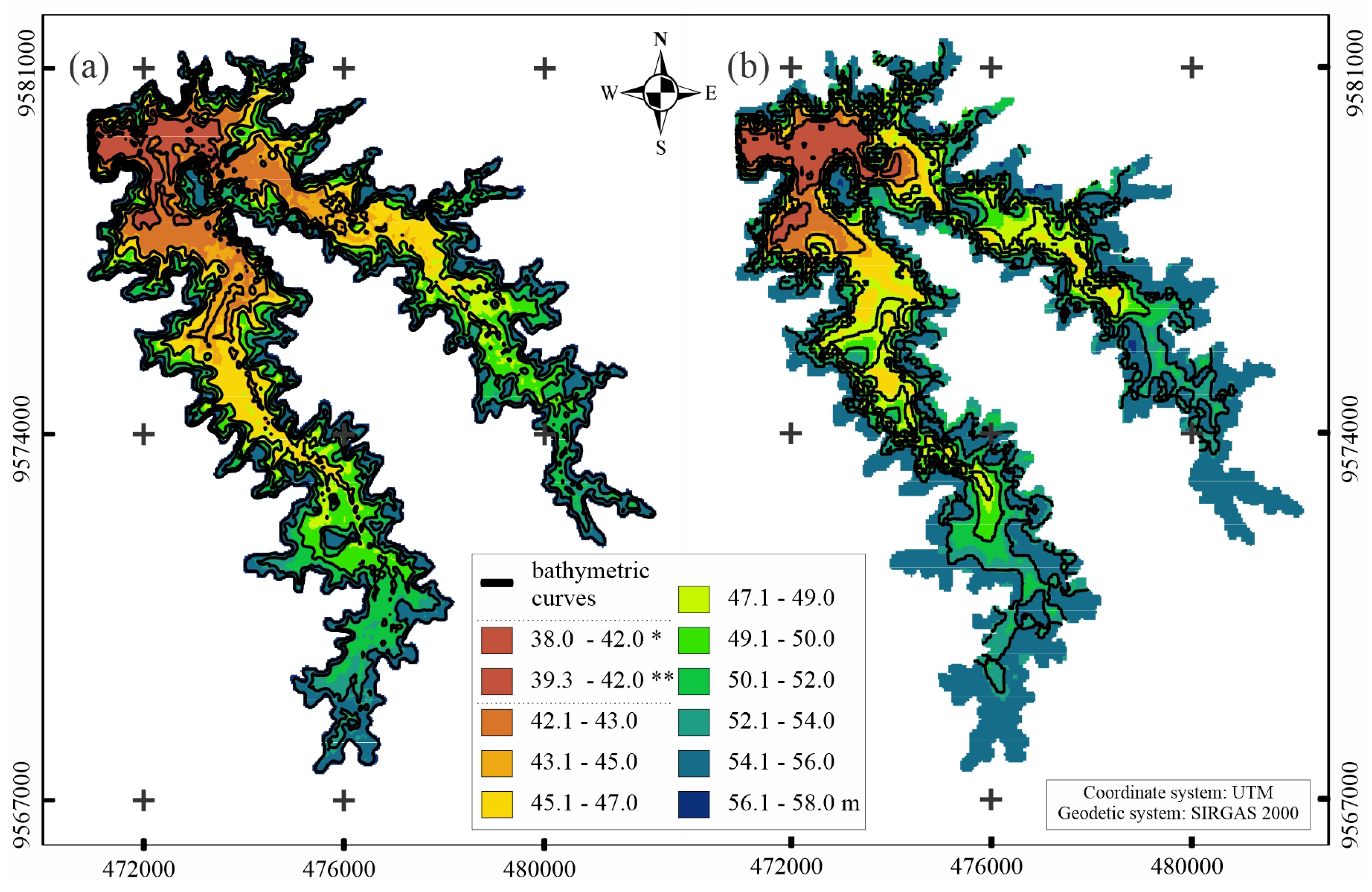Simplified Method for the Assessment of Siltation in Semiarid Reservoirs Using Satellite Imagery
Abstract
:1. Introduction
2. Materials and Methods
2.1. Bathymetric Survey Using the Simplified Remote-Sensing Method
2.2. Application of the Bathymetric Survey Using Remote Sensing Simplified Method
2.3. Conventional Bathymetric Survey—Comparative Validation
2.4. Uncertainties of the Bathymetric Method Concerning Water Availability
3. Results and Discussion
3.1. Bathymetric Survey Using Remote Sensing Simplified Method—BRS
3.2. Uncertainty of the Bathymetric Method with Regards to Water Availability
4. Conclusions
Author Contributions
Funding
Acknowledgments
Conflicts of Interest
Abbreviations
| INMET | National Institute of Meteorology of Brazil |
| PPGEA/UFC | The Postgraduate Program in Agricultural Engineering of the Federal University of Ceará |
References
- Vörösmarty, C.J.; Sahagian, D. Anthropogenic Disturbance of the Terrestrial Water Cycle. BioScience 2000, 50, 753–765. [Google Scholar] [CrossRef]
- de Araújo, J.C.; Güntner, A.; Bronstert, A. Loss of reservoir volume by sediment deposition and its impact on water availability in semiarid Brazil. Hydrol. Sci. J. 2006, 51, 157–170. [Google Scholar] [CrossRef] [Green Version]
- Habets, F.; Molénat, J.; Carluer, N.; Douez, O.; Leenhardt, D. The cumulative impacts of small reservoirs on hydrology: A review. Sci. Total Environ. 2018, 643, 850–867. [Google Scholar] [CrossRef]
- Andrade, E.M.; Araújo, L.F.P.; Rosa, M.F.; Disney, W.; Alves, A.B. Seleção dos indicadores da qualidade das águas superficiais pelo emprego da análise multivariada. Engenharia Agríccola Jaboticabal 2007, 27, 683–690. [Google Scholar] [CrossRef] [Green Version]
- Do Amaral, A.A.; Pires, S.C.; Ferrari, J.L. Qualidade da água e do sedimento de fundo de alguns córregos do município de Castelo, Estado do Espírito Santo. REVISTA AGRO@MBIENTE ON-LINE 2014, 8, 194. [Google Scholar] [CrossRef] [Green Version]
- de Araújo, J.C.; Bronstert, A. A method to assess hydrological drought in semi-arid environments and its application to the Jaguaribe River basin, Brazil. Water Int. 2016, 41, 213–230. [Google Scholar] [CrossRef]
- Agostinho, A.A.; Gomes, L.C.; Santos, N.C.L.; Ortega, J.C.G.; Pelicice, F.M. Fish assemblages in Neotropical reservoirs: Colonization patterns, impacts and management. Fish. Res. 2016, 173, 26–36. [Google Scholar] [CrossRef]
- Campos, J.N.B. Modeling the Yield–Evaporation–Spill in the Reservoir Storage Process: The Regulation Triangle Diagram. Water Resour. Manag. 2010, 24, 3487–3511. [Google Scholar] [CrossRef] [Green Version]
- Lima Neto, I.E.; Wiegand, M.C.; de Araújo, J.C. Sediment redistribution due to a dense reservoir network in a large semi-arid Brazilian basin. Hydrol. Sci. J. 2011, 56, 319–333. [Google Scholar] [CrossRef] [Green Version]
- Lira, D.; Toledo, C.; Mamede, G. Silting in the dense reservoir network of the Pereira de Miranda catchment. Engenharia Agrícola 2014, 34, 671–682. [Google Scholar] [CrossRef] [Green Version]
- Krol, M.S.; de Vries, M.J.; van Oel, P.R.; de Araújo, J.C. Sustainability of Small Reservoirs and Large Scale Water Availability Under Current Conditions and Climate Change. Water Resour. Manag. 2011, 25, 3017–3026. [Google Scholar] [CrossRef] [Green Version]
- Mamede, G.L.; Araujo, N.A.M.; Schneider, C.M.; de Araujo, J.C.; Herrmann, H.J. Overspill avalanching in a dense reservoir network. Proc. Natl. Acad. Sci. USA 2012, 109, 7191–7195. [Google Scholar] [CrossRef] [Green Version]
- Santos, J.Y.G.; Cunha, T.B.; Vianna, P.C.G. Conflito pelo uso da água no sertão paraibano: O estudo de caso do açude São Francisco II, Teixeira (PB). Cadernos do Logepa 2011, 6, 140–160. [Google Scholar]
- Foteh, R.; Garg, V.; Nikam, B.R.; Khadatare, M.Y.; Aggarwal, S.P.; Kumar, A.S. Reservoir Sedimentation Assessment Through Remote Sensing and Hydrological Modelling. J. Indian Soc. Remote Sens. 2018, 46, 1893–1905. [Google Scholar] [CrossRef]
- Guo, K.; Zou, T.; Jiang, D.; Tang, C.; Zhang, H. Variability of Yellow River turbid plume detected with satellite remote sensing during water-sediment regulation. Cont. Shelf Res. 2017, 135, 74–85. [Google Scholar] [CrossRef] [Green Version]
- Lin, S.; Qi, J.; Jones, J.R.; Stevenson, R.J. Effects of sediments and coloured dissolved organic matter on remote sensing of chlorophyll-a using Landsat TM/ETM+ over turbid waters. Int. J. Remote Sens. 2018, 39, 1421–1440. [Google Scholar] [CrossRef]
- Arsen, A.; Crétaux, J.F.; Berge-Nguyen, M.; del Rio, R. Remote Sensing-Derived Bathymetry of Lake Poopó. Remote Sens. 2013, 6, 407–420. [Google Scholar] [CrossRef] [Green Version]
- de Toledo, C.E.; de Araújo, J.C.; de Almeida, C.L. The use of remote-sensing techniques to monitor dense reservoir networks in the Brazilian semiarid region. Int. J. Remote Sens. 2014, 35, 3683–3699. [Google Scholar] [CrossRef]
- Flener, C.; Lotsari, E.; Alho, P.; Käyhkö, J. Comparison of empirical and theoretical remote sensing based bathymetry models in river environments. River Res. Appl. 2012, 28, 118–133. [Google Scholar] [CrossRef]
- Lima, J.R.d.C.; Shinozaki-Mendes, R.A.; de Almeida, A.Q. Estimativa da batimetria do açude do Saco-PE com auxílio de dados orbitais. Engenharia Agrícola 2013, 33, 1017–1023. [Google Scholar] [CrossRef]
- Narasayya, K. Assessment of reservoir sedimentation using remote sensing satellite imageries. Asian J. Geoinform. 2013, 12. [Google Scholar] [CrossRef]
- Palmer, S.C.; Kutser, T.; Hunter, P.D. Remote sensing of inland waters: Challenges, progress and future directions. Remote Sens. Environ. 2015, 157, 1–8. [Google Scholar] [CrossRef] [Green Version]
- Peng, D.; Guo, S.; Liu, P.; Liu, T. Reservoir Storage Curve Estimation Based on Remote Sensing Data. J. Hydrol. Eng. 2006, 11, 165–172. [Google Scholar] [CrossRef]
- Tong, X.; Pan, H.; Xie, H.; Xu, X.; Li, F.; Chen, L.; Luo, X.; Liu, S.; Chen, P.; Jin, Y. Estimating water volume variations in Lake Victoria over the past 22 years using multi-mission altimetry and remotely sensed images. Remote Sens. Environ. 2016, 187, 400–413. [Google Scholar] [CrossRef]
- Keys, T.A.; Scott, D.T. Monitoring volumetric fluctuations in tropical lakes and reservoirs using satellite remote sensing. Lake Reserv. Manag. 2018, 34, 154–166. [Google Scholar] [CrossRef]
- Rokni, K.; Ahmad, A.; Selamat, A.; Hazini, S. Water Feature Extraction and Change Detection Using Multitemporal Landsat Imagery. Remote Sens. 2014, 6, 4173–4189. [Google Scholar] [CrossRef] [Green Version]
- Feyisa, G.L.; Meilby, H.; Fensholt, R.; Proud, S.R. Automated Water Extraction Index: A new technique for surface water mapping using Landsat imagery. Remote Sens. Environ. 2014, 140, 23–35. [Google Scholar] [CrossRef]
- Hereher, M.E. Environmental monitoring and change assessment of Toshka lakes in southern Egypt using remote sensing. Environ. Earth Sci. 2015, 73, 3623–3632. [Google Scholar] [CrossRef]
- Jones, J. Efficient Wetland Surface Water Detection and Monitoring via Landsat: Comparison with in situ Data from the Everglades Depth Estimation Network. Remote Sens. 2015, 7, 12503–12538. [Google Scholar] [CrossRef] [Green Version]
- Xie, H.; Luo, X.; Xu, X.; Pan, H.; Tong, X. Automated Subpixel Surface Water Mapping from Heterogeneous Urban Environments Using Landsat 8 OLI Imagery. Remote Sens. 2016, 8, 584. [Google Scholar] [CrossRef]
- Chipman, J. A Multisensor Approach to Satellite Monitoring of Trends in Lake Area, Water Level, and Volume. Remote Sens. 2019, 11, 158. [Google Scholar] [CrossRef]
- Zhang, S.; Foerster, S.; Medeiros, P.; de Araújo, J.C.; Motagh, M.; Waske, B. Bathymetric survey of water reservoirs in north-eastern Brazil based on TanDEM-X satellite data. Sci. Total Environ. 2016, 571, 575–593. [Google Scholar] [CrossRef]
- Coelho, C.; Heim, B.; Foerster, S.; Brosinsky, A.; de Araújo, J.; Coelho, C.; Heim, B.; Foerster, S.; Brosinsky, A.; De Araújo, J.C. In Situ and Satellite Observation of CDOM and Chlorophyll-a Dynamics in Small Water Surface Reservoirs in the Brazilian Semiarid Region. Water 2017, 9, 913. [Google Scholar] [CrossRef]
- Zhang, S.; Foerster, S.; Medeiros, P.; de Araújo, J.C.; Waske, B. Effective water surface mapping in macrophyte-covered reservoirs in NE Brazil based on TerraSAR-X time series. Int. J. Appl. Earth Obs. Geoinf. 2018, 69, 41–55. [Google Scholar] [CrossRef]
- Pereira, B.; Medeiros, P.; Francke, T.; Ramalho, G.; Foerster, S.; De Araújo, J.C. Assessment of the geometry and volumes of small surface water reservoirs by remote sensing in a semi-arid region with high reservoir density. Hydrol. Sci. J. 2019, 64, 66–79. [Google Scholar] [CrossRef]
- Andres, L.; Boateng, K.; Borja-Vega, C.; Thomas, E. A Review of In-Situ and Remote Sensing Technologies to Monitor Water and Sanitation Interventions. Water 2018, 10, 756. [Google Scholar] [CrossRef]
- Baup, F.; Frappart, F.; Maubant, J. Combining high-resolution satellite images and altimetry to estimate the volume of small lakes. Hydrol. Earth Syst. Sci. 2014, 18, 2007–2020. [Google Scholar] [CrossRef] [Green Version]
- Van Den Hoek, J.; Getirana, A.; Jung, H.; Okeowo, M.; Lee, H. Monitoring Reservoir Drought Dynamics with Landsat and Radar/Lidar Altimetry Time Series in Persistently Cloudy Eastern Brazil. Remote Sens. 2019, 11, 827. [Google Scholar] [CrossRef]
- Hutchinson, M.F. Calculation of hydrologically sound digital elevation models. In Proceedings of the Third International Symposium on Spatial Data Handling, Sydney, Australia, 17–19 August 1988; pp. 117–133. [Google Scholar]
- Hutchinson, M.F. A new procedure for gridding elevation and stream line data with automatic removal of spurious pits. J. Hydrol. 1989, 106, 211–232. [Google Scholar] [CrossRef]
- Hutchinson, M.F. Development of a Continent-Wide DEM with Applications to Terrain and Climate Analysis. In Environmental Modeling with GIS; Goodchild, M.F., Parks, B.O., Steyaert, L.T., Eds.; Oxford University Press: New York, NY, USA, 1993; pp. 392–399. [Google Scholar]
- USGS. Landsat 5 History; United States Geological Survey: Reston, VA, USA, 2015.
- SEINFRA, C. Tabela de Custos—Secretária de Infraestrutura do Estado do Ceará; State Government of Ceará: Fortaleza, Brazil, 2017.
- Mein, R.G.; McMahon, T.A. River and Reservoir Yield; Water Resources Pubns: Littleton, CO, USA, 1987; p. 368. [Google Scholar]
- Wiegand, M.C.; Piedra, J.I.G.; de Araújo, J.C. Vulnerabilidade à eutrofização de dois lagos tropicais de climas úmido (Cuba) e semiárido (Brasil). Engenharia Sanitária e Ambiental 2016, 21, 415–424. [Google Scholar] [CrossRef] [Green Version]
- Lodhi, M.A.; Rundquist, D.C.; Han, L.; Kuzila, M.S. The potential for remote sensing of loess soils suspended in surface waters. J. Am. Water Resour. Assoc. 2007, 33, 111–117. [Google Scholar] [CrossRef]
- Rudorff, C.M.; Novo, E.M.L.M.; Galvao, L.S.; Pereira Filho, W. Análise derivativa de dados hiperespectrais medidos em nível de campo e orbital para caracterizar a composição de águas opticamente complexas na Amazônia. Acta Amaz. 2007, 37, 269–280. [Google Scholar] [CrossRef]
- Meireles, A.; Chaves, L.; Lopes, F.; Andrade, E.; Becker, H. Qualidade da agua em função da criação de peixes no açude Orós, Ceará. In Proceedings of the I Simpósio Brasileiro de Recursos Naturais do Semiárido, Iguatu, Brazil, 22–24 May 2013; pp. 1–6. [Google Scholar]
- Beveridge, M.C.M. Cage Aquaculture; Wiley-Blackwell: Oxford, UK, 2004; p. 380. [Google Scholar]
- Henry-Silva, G.G.; Camargo, A.F.M. Efficiency of aquatic macrophytes to treat Nile tilapia pond effluents. Sci. Agric. 2006, 63, 433–438. [Google Scholar] [CrossRef]











| Image Date | Measured Water-Level Altitude | Stored Volume | Stored Volume |
|---|---|---|---|
| (m.a.s.l.) | (Cubic Hectometers) | (%) | |
| 7 April 2011 | 55.32 | 236 | 66 |
| 9 July 2010 | 54.58 | 208 | 58 |
| 5 October 2007 | 52.71 | 146 | 41 |
| 12 August 1999 | 48.05 | 46 | 13 |
| 30 October 1993 | 47.41 | 37 | 10 |
| Data | Source/Observation |
|---|---|
| Mean inflow discharge * | Calculated by water balance from the measured daily volume of the reservoir |
| Coefficient of variation annual discharge * | Calculated from the annual inflow |
| Morphological parameter () | Calculated from the elevation-area-volume curves (original, 2009/CBS, 2014/BRS) |
| Evaporation of the dry period * | Climate station (INMET) |
| Maximum reservoir storage capacity | Original, 2009/CBS and 2014/BRS |
| Minimum operational volume | 10% of respective maximum storage capacity |
| Initial volume (first simulation year) | 50% of maximum storage capacity |
| Number of simulation years (synthetic series) * | 50,000 |
| Feature | Unit | Original | CBS | BRS | Difference (%) |
|---|---|---|---|---|---|
| Maximum depth | meters | 22.0 | 20.0 | 18.7 | 7 |
| Maximum water surface | hectare | 5700 | 4849 | 5221 | 8 |
| Storage capacity | cubic hectometers | 396 | 360 | 320 | 11 |
| Dry bulk density | tons per cubic meter | 1.30 | - | - | - |
| Average silted mass | tons per decade | - | 89,000 | 172,421 | 94 |
| Average silted volume | cubic hectometers per decade | - | 6.9 | 13.3 | 93 |
| Sedimentation rate | percentage per decade | - | 1.7 | 3.3 | 94 |
| Water Yield | Survey Method | Storage Capacity | |||||||
|---|---|---|---|---|---|---|---|---|---|
| (hm) | CBS | BRS | CBS | BRS | |||||
| 74.5 | 73.8 | 360 | 320 | −0.7 | 74.5 | −40 | 360 | 0.09 | |
| 105.8 | 102.0 | - | - | −3.8 | 105.8 | - | - | 0.33 | |
| 124.2 | 119.9 | - | - | −4.4 | 124.2 | - | - | 0.32 | |
© 2019 by the authors. Licensee MDPI, Basel, Switzerland. This article is an open access article distributed under the terms and conditions of the Creative Commons Attribution (CC BY) license (http://creativecommons.org/licenses/by/4.0/).
Share and Cite
Lopes, J.W.B.; de Araújo, J.C. Simplified Method for the Assessment of Siltation in Semiarid Reservoirs Using Satellite Imagery. Water 2019, 11, 998. https://doi.org/10.3390/w11050998
Lopes JWB, de Araújo JC. Simplified Method for the Assessment of Siltation in Semiarid Reservoirs Using Satellite Imagery. Water. 2019; 11(5):998. https://doi.org/10.3390/w11050998
Chicago/Turabian StyleLopes, José Wellington Batista, and José Carlos de Araújo. 2019. "Simplified Method for the Assessment of Siltation in Semiarid Reservoirs Using Satellite Imagery" Water 11, no. 5: 998. https://doi.org/10.3390/w11050998
APA StyleLopes, J. W. B., & de Araújo, J. C. (2019). Simplified Method for the Assessment of Siltation in Semiarid Reservoirs Using Satellite Imagery. Water, 11(5), 998. https://doi.org/10.3390/w11050998






